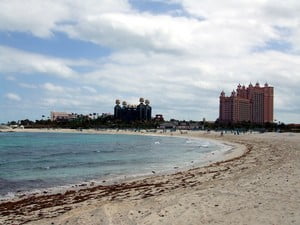Only a small number of gemstones tend to be exclusive to a specific location. However, that is the case with a stunning blue stone called larimar. Sometimes referred to as the “Atlantis” or “dolphin” stone, larimar is found only in the Dominican Republic.
Larimar is a part of the terrestrial crust of the area known as Barahona. Originally found by a priest, his request for permission to explore the nearby mines somehow fell through the cracks. Consequently, the gemstone remained virtually unknown until 1974.
During a walk on the beach, American Peace Corps worker, Norman Rilling, and Domincan native, Miquel Mendez, spotted an unusual blue stone. Picking it up and examining it, the pair was certain they had found something unique. Later it would be determined that they had rediscovered what would eventually become known as larimar.
The gem was named after Mendez’s daughter, Larissa, and the Spanish word for sea – – Mar.The stones found on the beach were identified as alluvial sediment that had been washed down stream by the Bahoruco River. The new treasure was eventually followed up the river to a location near the city of Barahona. This is where the largest amounts of this gem are located.
Larimar is a variety of pectolite, which is itself relatively common. But only a small percentage of pectolite results in larimar. For this reason, it is a highly popular choice among gemstone and jewelry collectors alike.
Larimar possesses a silky luster. It sometimes exhibits white streaks red inclusions. It ranges from translucent to transparent in nature. Its stunning turquoise blue color has led those with a less trained eye to believe it might be the highly sought after turquoise gem. Tests proved that it was not turquoise but, in fact, a rare form of pectolite.
Larimar varies between five and seven on the Mohs scale of hardness; with the majority of it ranging closer to a seven. It is suitable for setting into jewelry, but recommended for pieces that are less likely to take a beating. While it is sometimes set into rings and bracelets, it is more often seen in necklaces, pendants, earrings, and brooches.
Most jewelers choose to set the stone into silver, however, some of the higher quality stones have been set into gold. Quality is determined by the color of the stone. The lighter the color, the lower the considered quality. Stones with a more greenish tint to them are less popular overall, although some collectors like that variation.
Care must be taken to keep larimar stones in tact and to maintain their vibrant color. While they have some hardness to them, they are still subject to cracks and breaks. The gem is also photosensitive, which can cause it to fade over time.
Larimar should never be immersed into harsh chemicals or put into an ultrasonic cleaner. It should simply be cleaned with a slightly damp cloth.
Storing of larimar pieces also requires care. It is recommended that each piece be pouched in cloth or velvet before storing together or with other jewelry items.
Larimar is believed to possess metaphysical properties that enlighten its wearer while also helping to heal emotional, mental, and/or spiritual problems. It also known to help people view problems from differing perspectives in order to allow them to make wise decisions.
Because it is blue, larimar is considered tranquility stone. It promotes clear vision and internal peace while reducing stress and anxiety.
Larimar also possesses healing powers. It stimulates the heart and improves the circulatory system.







